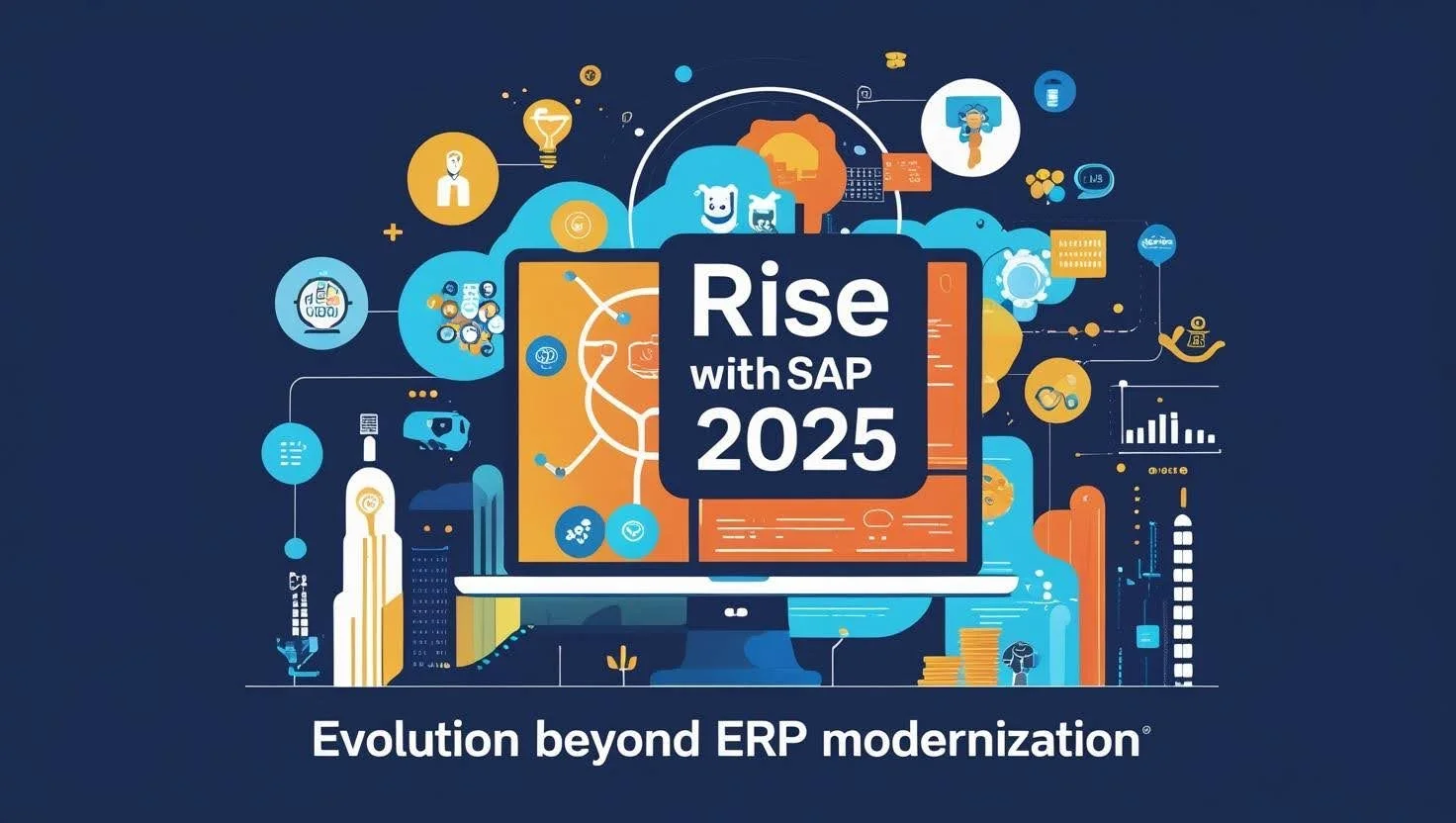AI is no longer a buzzword for finance teams — SAP’s Q3 2025 Business AI updates finally make it real.
From conversational invoice inquiries in AP, to natural-language explanations for asset values and costing variances, to smart, policy-aware travel booking in Concur — this release is a turning point.
We break down the most practical, high-impact AI features finance teams can use right now, what they mean for AP, Controlling, Asset Accounting, and T&E, and the actions finance leaders should take next.
Beyond the General Ledger: How SAP’s Acquisition Strategy Built the Modern Finance Function
SAP didn’t just build ERP — it built the modern finance function.
From Business Objects to Ariba, Concur, and Signavio, every acquisition was a deliberate move to expand the CFO’s reach — from reporting to spend control, process visibility, and AI-driven insight.
This post breaks down how SAP’s 20-year acquisition strategy quietly redefined what “finance transformation” really means — and why the modern CFO’s tech stack now extends far beyond the ledger.
It’s not just about recording numbers anymore. It’s about governing spend, accelerating processes, and predicting outcomes.
A Global Celebration of Code: Reflecting on SAP Devtoberfest 2025
October wasn’t just another month for the SAP developer community—it was a festival of innovation, collaboration, and code.
From September 29 to October 24, SAP Devtoberfest 2025 brought developers together worldwide for a month-long virtual experience leading up to SAP TechEd 2025 (Nov 4–6).
In this recap, we unpack what made this year’s event remarkable:
💡 Themed Learning Weeks – From ABAP Cloud and Fiori tooling to Integration, Data & AI, and CAP development.
🎮 Gamified Challenges – Hands-on coding contests, tutorials, and leaderboards that turned learning into play.
☁️ Cloud & AI Focus – Deep dives into SAP BTP, CAP, Kyma, and Joule—showing how AI and cloud-native innovation are shaping enterprise development.
🌍 Community & Open Source – A global, open-source-driven spirit that connected developers from the US to Berlin.
🌱 Tech for Good – A strong sustainability message encouraging developers to build code that creates real-world impact.
If you’re part of the SAP ecosystem—or simply passionate about cloud, AI, and enterprise apps—this reflection captures the key themes and lessons shaping the next wave of intelligent development.
Beyond the Debate: How SAP Blends Best-of-Breed Innovation with Suite Power through Apps, Data, and AI
For too long, organizations—especially finance leaders—have been forced to choose: an integrated suite or agile, best-of-breed innovation. The choice meant trading seamless data for cutting-edge tools, or vice versa.
SAP is rewriting the rules.
This new article breaks down the strategic trio delivering "both/and": Apps, Data (via the Business Data Fabric), and Embedded AI (Joule).
We explore how this approach provides:
The agility to adopt new innovations instantly.
Confidence in a single, trusted view of data.
Intelligence embedded directly into financial decisions.
If you're currently wrestling with system fragmentation, data silos, or slow innovation cycles, this is a must-read.
SAP Activate in the Age of AI: Transforming the Realize Phase with Joule and BTP
Is your SAP Activate Realize phase slow, manual, and full of risk? It doesn't have to be. 💡
The integration of AI and SAP BTP has given us the tools to finally deliver on the promise of true agile S/4HANA transformation. This new article breaks down the strategic shift.
We're covering: ✅ How SAP Joule cuts documentation time. ✅ The practical steps to enforce a Clean Core governance in the build sprints. ✅ Why the modern consultant is an AI Orchestrator, not a coder.
If you’re a PM or architect planning a transformation in the next 12 months, this is a must-read. Save this post and share your tips!
The SAP Partner Advantage: The Strategic Value of Free Licenses for Finance
Free doesn’t always mean limited—in SAP’s partner ecosystem, free licenses can unlock real strategic value for finance organizations.
In this blog, we break down how SAP’s partner license offerings enable finance teams to experiment, innovate, and test solutions without upfront cost. Whether it’s piloting new analytics, building proof-of-concept automations, or accelerating adoption of SAP’s latest tools, free licenses create a sandbox for value creation.
We explore:
How partners leverage free licenses to co-innovate with finance teams.
The hidden benefits of experimenting without additional license spend.
Why free access accelerates both transformation projects and user adoption.
For finance leaders, these licenses aren’t just “extras”—they’re a way to lower risk, validate investments, and fast-track business outcomes.
Read the full blog to understand how SAP’s partner advantage can work in your favor.
Cash Flow Crisis or Cash Flow Control: The SAP S/4HANA Perspective
In today's volatile economic landscape, a cash flow crisis is a CFO's worst nightmare. But what if you could move beyond reactive firefighting to gain complete control over your company's cash? This blog explores how modern SAP solutions are transforming treasury management. We'll dive into the capabilities of SAP S/4HANA that provide a real-time, holistic view of your organization's liquidity, moving beyond traditional reporting. Discover how advanced features use integrated data from across the enterprise to deliver precise liquidity forecasting, helping you anticipate and prevent potential shortfalls. Finally, we'll highlight how automation and seamless bank integration are freeing up finance teams from manual tasks, enabling them to shift their focus from mere survival to strategic growth. The future of cash management isn't about crisis—it's about control.
Beyond the Hype: Demystifying SAP BTP vs. SAP Business Data Cloud for Finance Leaders
Struggling to make sense of the latest SAP acronyms? You're not alone. The conversation around SAP BTP and SAP Business Data Cloud (BDC) can get confusing, with both promising to be the key to digital transformation.
But what if you didn't have to choose?
Our latest blog post cuts through the noise, explaining how these two powerful platforms work not as competitors, but as two parts of a single, integrated strategy. We'll show you how BTP is your engine for operational agility, while BDC is your new foundation for strategic, AI-driven insights.
Read the full post to discover how you can move from a reactive, reporting-based finance function to a proactive, strategic partner.
The CFO's AI Playbook: Unleashing Next-Gen Financial Operations with Generative AI & ML in SAP S/4HANA
In today's rapidly evolving financial landscape, how can CFOs truly unlock strategic value and unprecedented efficiency beyond traditional reporting?
Our latest blog unveils "The CFO's AI Playbook," a guide to leveraging the powerful combination of Generative AI (GenAI) and Machine Learning (ML) seamlessly integrated within SAP S/4HANA.
Key highlights:
Intelligent Automation: Streamline Accounts Payable/Receivable and financial close processes with SAP Business AI, dramatically reducing manual effort (e.g., a 71% reduction in AR matching effort).
Enhanced Forecasting & Planning: Drive proactive working capital optimization through AI-powered predictive analytics and dynamic scenario planning.
Proactive Risk & Fraud Detection: Leverage solutions like SAP Business Integrity Screening to identify anomalies and prevent fraud in real-time.
Generative Insights: Empower finance teams with automated reporting, narrative generation, and intelligent querying using GenAI.
Strategic Roadmap for Adoption: Discover a clear playbook for defining vision, identifying high-impact use cases, and ensuring data quality for successful AI implementation.
This isn't just about integrating new tech—it's about transforming finance into an intelligent, insightful, and profoundly impactful driver of business value.
From On-Premise to Omni-Cloud: How the SAP Business Suite Acceleration Program with Microsoft Azure is Redefining Enterprise Transformation
SAP customers know cloud is the future—but how do you modernize without disrupting critical operations?
The SAP Business Suite Acceleration Program with Microsoft Azure helps enterprises move beyond lift-and-shift with a smarter, phased approach.
Key highlights:
Hybrid Cloud Flexibility – Run SAP workloads across on-prem and Azure
Finance-Ready Modernization – Build the foundation for faster closes and AI-driven insights
Embedded AI – Use SAP Joule + Microsoft Copilot to boost productivity
S/4HANA Preparation – Simplify, streamline, and de-risk your path forward
This isn’t just about migration—it’s about transformation designed for scale, speed, and strategy.
RISE with SAP 2025: Evolving Beyond ERP Modernization
It’s about reinventing the business—with AI, industry innovation, and sustainability at the core.
At #SAPSapphire, SAP redefined RISE as a platform for transformation:
Embedded Joule AI for forecasting, planning, and anomaly detection
Industry cloud capabilities tailored to real outcomes
Sustainability and ESG tracking embedded in core processes
Extensibility via SAP BTP and low-code tools
Clean core + flexible architecture = faster, safer innovation
Finance teams benefit through intelligent insights, agile compliance, and scalable automation.
Perplexity and SAP – Turbocharging Joule with Real-Time Answers and What It Means for Finance
At #SAPSapphire, SAP announced a powerful integration: Perplexity is now embedded in Joule, enabling finance teams to get real-time, structured answers from SAP data—instantly, in natural language.
Just last week, Perplexity also made waves in finance—integrating with SEC/EDGAR to open up 10-Ks and earnings reports to natural language search. No dashboards. No subscriptions. Just fast, cited insights.
The future of finance intelligence is no longer locked in reports. It’s conversational.
Recap: Key Highlights from SAP Sapphire 2025 for Finance Leaders
At SAP Sapphire 2025, one thing was clear: finance teams are leading the next wave of enterprise transformation.
✔️ From AI-powered automation in SAP S/4HANA to deeper planning integration in SAP Analytics Cloud
✔️ From real-time ESG reporting with the Green Ledger to strategic insights from global CFOs
The message was consistent — finance is evolving from record-keeping to value creation.
This recap covers the most important updates for finance professionals, including embedded AI, connected planning, and the technologies reshaping the CFO’s role.
Get Ready: Key Updates in SAP Analytics Cloud Q2 2025 for Finance Teams
SAP Analytics Cloud is leveling up in Q2 2025 — and finance teams are set to benefit the most. From tighter integration with SAP PaPM in Multi Actions to live connectivity with Google BigQuery, this release focuses on automation, insight, and speed.
This blog covers the top updates finance professionals need to know — including Smart Insights in optimized stories, Joule-powered natural language queries, and new ways to pin insights in Data Analyzer — all designed to supercharge planning, analysis, and decision-making.
Mastering ACDOCA: 7 Essential Universal Journal Insights for SAP S/4HANA Consultants (2025 Edition)
In SAP S/4HANA Finance, the Universal Journal (ACDOCA) forms the core of financial and controlling data. This blog breaks down the key things every consultant needs to know — from Margin Analysis and document splitting to embedded analytics and custom field extensions.
Whether you're implementing, migrating, or optimizing, this guide covers the essentials of ACDOCA and how to use it effectively in 2025.
AI-Driven Automation in Accounting and Finance with SAP S/4HANA Cloud Private Edition 2023 FPS03
SAP S/4HANA Cloud Private Edition 2023 FPS03 introduces powerful AI-driven capabilities that streamline core finance and operations processes. With innovations like Joule AI agents and Insight Apps—built on SAP Business Data Cloud—organizations can automate journal entries, predict labor demand, optimize sales fulfillment, and generate intelligent financial reports with minimal manual effort.
This blog explores the key AI features embedded in the FPS03 release and how they help finance teams shift from transactional processing to strategic analysis. By adopting these tools, businesses can reduce costs, enhance accuracy, and lay the foundation for a more agile, data-driven future in financial management.
Revolutionizing ABAP Development with Joule’s ABAP Developer in ABAP Cloud: Enhancing SAP FI Customization within ADT
Earlier this year, SAP announced the availability of Joule for ABAP developers, bringing AI-powered assistance directly into ADT. This transforms SAP FI customization with smart code completion, real-time error detection, and automated compliance checks—streamlining ABAP development for S/4HANA.
In this blog we will see how AI is changing SAP development.
SAP Business Data Cloud: Key Questions from the Launch
At the SAP Business Unleashed event, key insights were shared about how SAP BDC supports AI applications, real-time analytics, and advanced planning across business functions like finance, HR, and enterprise analytics. But with existing solutions like SAP Datasphere and SAP Business Suite already in play, many users have questions on how to integrate these tools effectively.
In this blog, we’ve compiled the top 18 frequently asked questions from SAP users, addressing strategic, technical, and adoption-related concerns around SAP BDC. Whether you’re a consultant, customer, or SAP enthusiast, this blog will help clarify how SAP BDC works and fits into the broader enterprise data ecosystem.
Monte Carlo Simulation in SAP Analytics Cloud Compass
Monte Carlo simulations use random sampling to model uncertainty and variability in decision-making. The name originates from the city in Monaco, known for its casinos, symbolizing randomness in probability-based simulations. While randomness may seem counterintuitive for business decisions, it provides a structured way to assess possible outcomes and mitigate risks. By running thousands or even millions of simulations, businesses can make informed choices based on probability distributions rather than single-point estimates.
Managing Data Migration During S/4HANA Conversion: Strategic Insights
This blog looks to address what truly determines success in an SAP data migration project: practical strategies and guiding principles, forged from real-world SAP ECC to S/4HANA conversions.




















